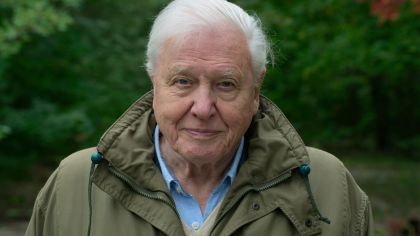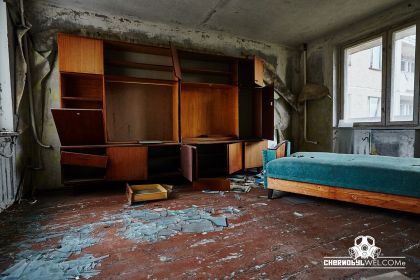If you’ve spent any time on the Internet, you’ll be well aware that Sir David Attenborough’s latest show – A Life On Our Planet – was released on Netflix this month. The documentary has taken the whole world by storm. Attenborough not only touched upon global environmental problems, but also on one of the worst nuclear disasters in human history – Chernobyl.
“This film is my witness statement and my vision of the future. The story of how we came to make this our greatest mistake and how if we start now, we can yet put it right”.
The new documentary by David Attenborough, released recently on Netflix, is unique not only because it starts, but also ends with episodes filmed in Ukraine – Chernobyl. It is also a testimony given by Attenborough in the case of the malicious destruction of planet Earth, spanning a career of the naturalist spanning nearly 70 years.
In his 94 years, Attenborough has visited every continent on the Earth, documenting the living world in all its variety and wonder. Now, for the first time he reflects upon both the defining moments of his life, experience, knowledge as a naturalist, and the devastating changes to our planet.

The naturalist David Attenborough in the Chernobyl Exclusion Zone
Credit: Netflix
In 1926, when Sir David was born, the planet was a full degree cooler. Using archive footage of his former work and more contemporary scenes of recent projects, he lays out the full extent of damage we have done to nature over the last 94 years.
Filming animals for 70 years, the naturalist has repeatedly visited the places that he had previously been and has seen with his own eyes how wildlife retreats under the onslaught of man, how the landscape changes beyond recognition, and how entire ecosystems disappear all during the lifespan of one person.
It can be seen how hard it is for Attenborough to give this evidence. He is physically hurt by the fact that many things that he saw with his own eyes, no one else will see. That humanity itself joyfully rushes into the abyss, getting out of which will be very, very difficult. But there is still hope.
Who is David Attenborough?

Sir David Attenborough, late 1950s.
Sir David Frederick Attenborough is an English broadcaster and natural historian. He is widely considered a national treasure in the UK, although he himself does not like the term. In 2002, he was named among the 100 Greatest Britons following a UK-wide poll for the BBC.
Attenborough was born 8 May 1926 in Isleworth, Middlesex (now part of West London), and grew up in College House on the campus of the University College, Leicester.

Photo: BBC 2019
He is best known for writing and presenting, in conjunction with the BBC Natural History Unit, the nine natural history documentary series forming the Life collection that together constitute a comprehensive survey of animal and plant life on Earth.
Sir David is a former senior manager at the BBC, having served as controller of BBC Two and director of programming for BBC Television in the 1960s and 1970s. He is the only person to have won BAFTAs for programmes in each of the black and white, colour, HD, 3D and 4K formats.
In 2018 and 2019, he received Primetime Emmy Awards for Outstanding Narrator. He considers his 2020 documentary film, David Attenborough: A Life On Our Planet, his personal witness statement of his life and the future. Sir David’s near 70-year career has seen him visit each of the seven continents and create some of the most impacting nature series in history, including Planet Earth and Blue Planet.
What is A Life On Our Planet about?
The career of David Attenborough, undoubtedly, deserves the deepest respect, and David Attenborough: A Life On Our Planet is a kind of summing up the results of a long creative life.
These themes are raised in one way or another in all his TV shows and films over the last three decades. That is why A Life On Our Planet may seem like a self-repetition to many, a film assembled from pieces of other programs.
It sees Attenborough recount what he’s learned over his many years of broadcasting, and proffer some dire warnings as to the future of life on our planet.
“I think we are at a crucial moment.”
Besides stating the problems, Attenborough this time also focuses on ways to solve them, proposing, albeit somewhat utopian, but feasible steps to prevent the global crisis. It is not for nothing that the film begins and ends in Chernobyl. By showing how the earth can become uninhabited through human fault, Attenborough shows how it heals itself when anthropogenic pressure disappears. The planet will be alright, as for us – no.
The film’s most striking moments arguably come from when Sir David talks directly to camera, addressing viewers and imparting bittersweet wisdom.
A Life On Our Planet: Chernobyl

Sir David Attenborough pictured in Pripyat (Chernobyl Exclusion Zone) while filming A Life on Our Planet
Photo: Joe Fereday/Silverback Films
The documentary, David Attenborough “A Life on Our Planet”opens with its title plot set in a desolate place. This is the Chernobyl Exclusion Zone – a place so utterly destroyed and scarred by humans. The City of Pripyat, once a noisy area that was evacuated after human error made it uninhabitable. Only later did directors Alastair Fothergill, Johnny Hughes and Keith Sholey pull the camera back to show that the area left in its place has become a wilderness paradise.
The first frame shows an abandoned house in the city of Pripyat, and on the roof of which you can see the well-known symbol of the Soviet Union “Hammer and Sickle”.

Footage from the documentary “A Life on our Planet”in Pripyat, David Attenborough.
David Attenborough is standing in a deserted building with broken walls and shattered glass on the floor. The abandoned, dilapidated buildings of the ghost town accurately convey the atmosphere of the post-apocalypse. He carefully examines the remains of the past life. Emptiness and pain are what can be seen in his eyes.
Chernobyl disaster – “Our Greatest Mistake”

Maslenitsa festival (the holiday “Farewell to Winter”) on the main square of Pripyat. March 1986.
Photo: Alexey Perminov
«This City in Ukraine was once Home to almost 50 thousand people. It had everything a community would need for a comfortable life. But on the 26th of April 1986, it suddenly became uninhabitable. The nearby Nuclear Power Station of Chernobyl exploded. And less than in 48 hours the city was evacuated. No one has lived here since”.
“The explosion was a result of bad planning and human error. Mistakes. It triggered an environmental catastrophe that had an impact across Europe”.

This 1986 aerial view of the Chernobyl Nuclear Power Plant in Chernobyl, Ukraine shows damage from an explosion and fire in reactor four on April 26, 1986 that sent large amounts of radioactive material into the atmosphere.
Photo: Volodymyr Repik, AP
“Many people regarded it as the most costly disaster in the history of mankind. But Chernobyl was a single event. The true tragedy of our time is still unfolding across the globe, barely noticeable. I’m talking about the loss of our planet, wild places. It’s biodiversity. The way we humans live on the earth now is sending biodiversity into a decline. This tool is happening as a result of bad planning and human error, and it too leads to what we see here – a place in which we cannot live. Natural world is fading. The evidence is all around. It’s happening in my lifetime. I’ve seen it with my own eyes”.
In addition to the documentary, David released a book, where he dedicated a chapter to the Chernobyl disaster – “Our Greatest Mistake”. With special trepidation, he talks about the ghost town – Pripyat, describing in detail the streets, houses, infrastructure of the city, imagining what it was like before the disaster:

The corner of Kurchatov Street and the main boulevard into the city, Lenina Prospekt.
Photo: Sergey Yakunin
“Pripyat in the Ukraine is a place unlike anywhere else I have been. It is a place of utter despair. On the face of it, it seems quite a pleasant town, with avenues, hotels, a square, a hospital, parks with fairground rides, a central post office, a railway station. It has several schools and swimming pools, cafés and bars, a restaurant by the river, shops, supermarkets and hairdressers, a theatre and a cinema, a dance hall, gymnasiums and a football stadium with an athletics track. It has all the amenities we humans have brought into existence to give us a content and comfortable life – all the elements of our homemade habitat”.
In “A Life On Our Planet” the naturalist shows us amateur film footage from the early 1980s with smiling people, mingling and pushing prams on the wide boulevards, taking ballet classes, swimming in the Olympic-size pool and boating on the river.
Now-look at Pripyat

Pripyat city center.
Yet no one lives in Pripyat today. The walls are crumbling. Its windows are broken. Its lintels are collapsing.
“I have to watch my step as I explore its dark, empty buildings. Chairs lie on their backs in the hairdressing salons, surrounded by dusty curlers and broken mirrors. Fluorescent tubes hang down from the supermarket ceiling. The parquet floor of the town hall is ripped up and scattered down the length of a grand, marble staircase. Exercise books litter the floors of school rooms, neat Cyrillic handwriting scoring their pages in blue ink. I find the pools emptied. The seats of sofas in the apartments have dropped to the floor. The beds are rotten. Almost everything is motionless – paused. If something is stirred by a gust of wind, it startles me”.

Abandonment apartment in Pripyat city.
“I’ve visited other post-human towns – Pompei, Angkor Wat and Machu Picchu – but here, the normality of the place forces your attention on the abnormality of its abandonment”.
Its structures and accoutrements are so familiar that you know their disuse cannot simply be due to the passing of ages. Pripyat is a place of utter despair because everything here, from the noticeboards that are no longer looked at, to the discarded slide rules in the science classroom, to the shattered piano in the café, is a monument to the capacity of humankind to lose everything it needs, and everything it treasures. David says, that we humans, alone on Earth, are powerful enough to create worlds, and then, to destroy them.
David explains what had happened on 26 April 1986, saying that “Chernobyl” was the result of bad planning and human error. The design of Chernobyl’s reactors had flaws, but operating staff were not aware of these and, in addition, were careless in their work.
Is Chernobyl the worst disaster in history?
Many have called Chernobyl the most costly environmental catastrophe in history, but Attenborough believes that this isn’t true. Something else has been unfolding, everywhere, across the globe, barely noticeable from day to day for much of the last century.
He compares Chernobyl and nowaday situation mentioning that THIS is also happening as the result of bad planning and human error. But it’s not one hapless accident. It didn’t begin with a single explosion. It started silently, before anyone realised it, as a result of causes that are multifarious, global and complex. Its fallout cannot be detected by a single instrument. It has taken hundreds of studies across the world to confirm that it is even happening. Its effects will be far more profound than the contamination of soils and waterways in a few unfortunate countries.

Pripyat after evacuation, view towards the Chernobyl NPP. Mid-May 1986.
Photo: Igor Gavrilov
The newly built city of Pripyat was the nearest town to the Chernobyl Power Plant at just under 2 miles away (3 km).
“Every morning, the first thing the people of Pripyat would have seen on drawing back the curtains in their apartments was the giant Nuclear Power Station that would one day destroy their lives. Most of the inhabitants worked there. The remainder relied on those who did it for their livelihoods. Many would have understood the dangers of living so close to it, yet I doubt whether any would have chosen to switch the reactors off. Chernobyl had brought them that precious commodity – a comfortable life”.
He thinks that right now “we are all people of Pripyat”. We live our comfortable lives in the shadow of a disaster of our own making. That disaster is being brought about by the very things that allow us to live our comfortable lives..
The famous naturalist is persuaded by the fading of the natural world.
“The evidence is all around. It has happened during my lifetime. I have seen it with my own eyes. It will lead to our destruction. Yet there is still time to switch off the reactor. There is a good alternative”.
Filming in the Chernobyl Exclusion Zone
The filmmakers have filmed in a number of dangerous locations over the past four years — including the site of the 1986 Chernobyl disaster.
At the end of September 2018, David spent about a week filming in Chernobyl Zone. Despite his age, he worked on the site like everyone else, and joked about his condition when someone obsessively wanted to help him.
The Chernobyl Exclusion Zone is a public place that you can easily visit. Just book your Chernobyl tour or contact us info@chernobylx.com.

David Attenborough in Chernobyl
Photo: Denis Vishnevskiy
It’s a metaphor for humankind’s capacity for destruction. “We had an idea that Chernobyl could be the perfect physical manifestation of both the wreckage we can create but also the ability for nature to recover,” says Jonnie Hughes, David Attenborough’s director-producer since 2000.
Now a mecca of biodiversity, Chernobyl is where animals run free among the abandoned laundrettes, riverfront coffee shops and public spaces. “You couldn’t get a better demonstration of how the world would recover if we weren’t around,” Jonnie adds weightily.

Sir David in cafe “Pripyat”, Chernobyl Exclusion Zone, 2018.
There was another reason for filming there. “It’s one of the few places that David had never been, so that was one thing that we could offer him,” reflects Jonnie of their week together in Ukraine. “You recognise all these things, the hairdressers, the cafe by the river, the municipal swimming pool, the hospital. All the schools with the books still on the floors and things like that,” he says of the Chernobyl scene-scapes.
Jonnie’s job as director-producer was to scope out the best abandoned scenes to make for good visuals, but for David Attenborough, the disaster site felt more bleak. “David said to me it felt like a place of real despair,” reveals Jonnie. “That’s the way he read it, but I guess maybe that’s because he was consciously aware of the power of us humans to get things so wrong.”
“Our forest film ends in Chernobyl,” producer Alistair Fothergill explained. “You think, ‘This is Armageddon environmentally’, and yet extraordinarily we had remote cameras there for four years capturing the wildlife there.”

Last scene in “A Life on our Planet”, David Attenborough. Panorama of the ghost city Pripyat.
He added that the Chernobyl film makes the case in Our Planet that, despite the harm wrought on the natural world by humans, there is still hope for the future.
“One of the reason we’re pleased to do this series for Netflix is the audience is a younger audience, largely under 30. This is the generation that’s inherited this damaged planet, and we feel it’s really important to help these people understand the problems and understand the solutions, but in a hopeful way.”
Honest, revealing and urgent, David Attenborough: A Life On Our Planet is a powerful first-hand account of humanity’s impact on nature and a message of hope for future generations.
If you’re eager about Chernobyl, you can arrange your visit in the Chernobyl Nuclear Power Plant or Pripyat already today.
In other cases, do not hesitate to CONTACT US, we will be happy to help you!
Radioactively yours ChernobylX.



 ChernobylX
ChernobylX
 ChernobylX
ChernobylX